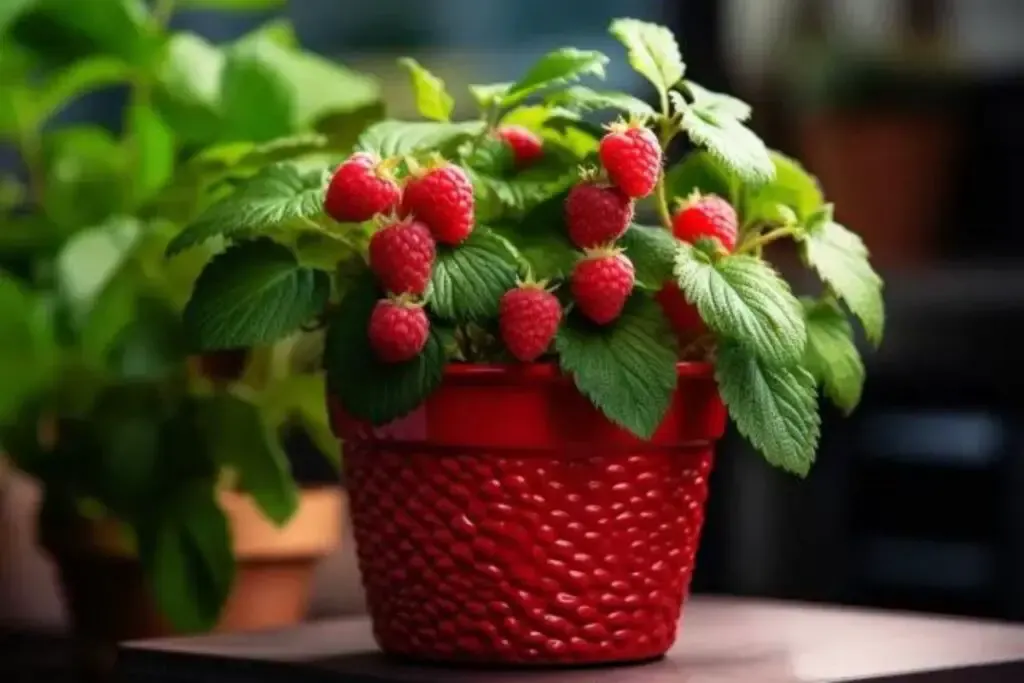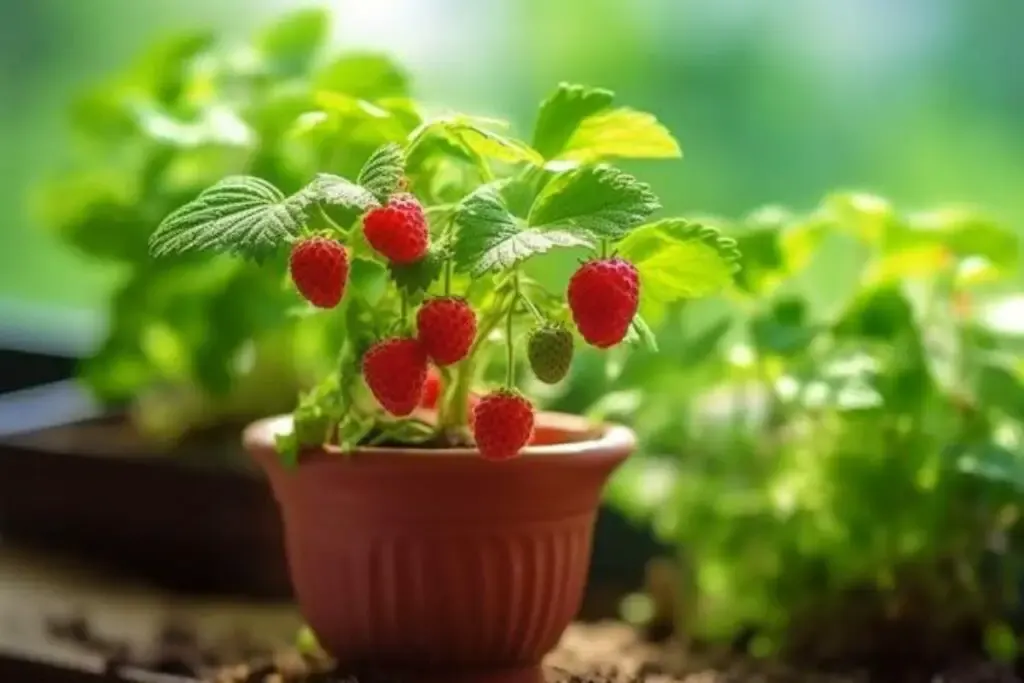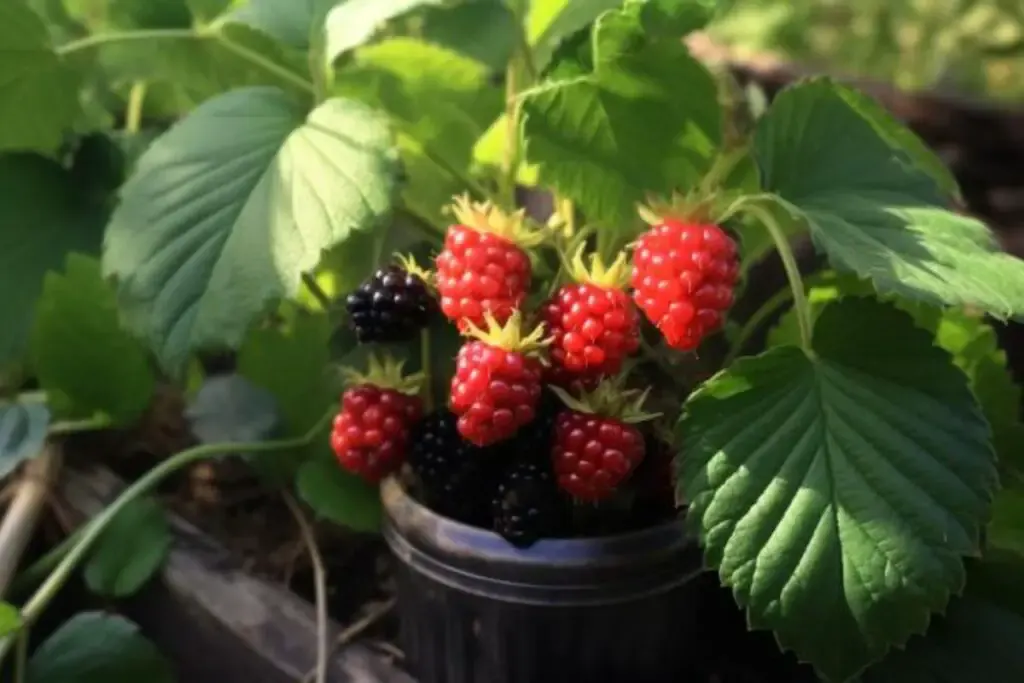Raspberries are a delightful treat straight from the garden, and the good news for those with limited space is that they can thrive in containers. Not only do potted raspberries offer convenience and accessibility, but they can also add a lush aesthetic to your balcony, patio, or urban garden.
As an expert gardening blogger, I’ve grown raspberries in various settings and have gathered a wealth of insights to help you become proficient in nurturing these berry plants in pots.
Do Raspberries Grow Well in Pots?
Absolutely! Raspberries can grow exceptionally well in pots, providing the container offers ample space for their roots to spread out. In fact, potted raspberries have some advantages over those grown in-ground.
Containers can help prevent the spread of soil-borne diseases and make it easier to manage the quality of the soil, ensuring your raspberry plants have the best environment to flourish.
Another significant advantage is that you can move the pots to optimize sunlight exposure or protect the plants from harsh weather. When growing raspberries in pots, you do need to be vigilant about watering, as potted plants can dry out faster than their in-ground counterparts.
However, with a good routine and a little TLC, your raspberry plants will not only survive but truly thrive.
Best Raspberry Varieties for Pots
Choosing the right variety of raspberries is key to successful pot gardening. Compact, dwarf, or bush-type raspberries are typically the best choices for container growing because they don’t need the extensive support systems that larger varieties do.
Let’s dive into some of the best varieties I’ve found for pot gardening.
1. Ruby Beauty

The ‘Ruby Beauty’ is a thornless dwarf variety that is ideal for container life. It grows to about 2-3 feet in height, making it perfect for small spaces and easy picking.
This variety doesn’t require trellising, which is a huge plus in the world of container gardening. Its compact size, however, doesn’t mean it skimps on production. You’ll be pleasantly surprised by the abundance of sweet, medium-sized berries it produces.
2. Raspberry Shortcake

‘Raspberry Shortcake’ is a revolutionary thornless raspberry plant bred specifically for container growth. Its rounded, bushy habit reaches a modest 2-3 feet tall and wide, perfect for those with limited space.
The berries are classic red, plump, and incredibly juicy, with a flavor that is simply indulgent. This variety is self-fertile, so you don’t need to grow more than one to enjoy a bountiful harvest.
3. Brazel Berries Raspberry

For the final pick, I’m drawn to the BrazelBerries series, particularly the ‘Raspberry Shortcake’ variety which I’ve had personal success with. These are some of the most container-friendly raspberries you’ll find on the market.
They’re compact, require no staking, and best of all, they’re prolific producers. The berries are a deep, luscious red and pack a wallop of flavor that will have you snacking right off the bush.
How to Grow and Care For Raspberries in Pots
Growing raspberries in pots isn’t just about selecting the right variety; it’s also about giving them the care they need to produce bountiful, sweet fruit. Let’s explore the essentials of planting and caring for your potted raspberry plants, so you can enjoy a fruitful harvest.
Planting
When planting raspberries in pots, timing is important. Early spring is the best time to plant, as this gives your raspberry bushes time to establish their root systems before the heat of summer kicks in. If you live in a milder climate, fall planting is also an option.
To plant, fill your pot with a quality soil mix, leaving space for the root ball. Place the plant so the crown is just at the soil surface, then fill in around it, gently tamping down the soil to eliminate air pockets. Water thoroughly after planting to settle the soil and give your raspberries a solid start.
Pot Size
Raspberries have a robust root system, so choosing a pot that can accommodate their growth is crucial. I recommend starting with a pot that’s at least 18-24 inches in diameter and equally deep.
This site gives the plants room to grow and ensures that you won’t have to re-pot them too frequently, which raspberries tend not to like.
Light
Raspberries need plenty of sunlight to thrive—around six to eight hours of direct light daily. Position your pots in a sunny spot where they can soak up those rays. If you’re in an especially hot climate, some afternoon shade can help prevent overheating.
Soil
The ideal soil for raspberries is well-draining and rich in organic matter. A mix of high-quality potting soil with some compost or aged manure will give your raspberries the nutrients they need. Be sure to avoid garden soil, as it can compact in pots and lead to poor drainage.
Water
Consistent moisture is key for raspberries, especially when they’re fruiting. However, you don’t want the soil to be waterlogged, as this can lead to root rot. Water when the top inch of soil feels dry to the touch. During the hotter parts of the year, you may need to water daily.
Temperature and Humidity
Raspberries are fairly adaptable, but they grow best when daytime temperatures are between 70-75°F (21-24°C) and nighttime temperatures don’t dip below freezing. While they can handle humidity, good air circulation is important to prevent fungal diseases, so make sure your pots aren’t too close together.
Fertilizer
Feed your raspberries with a balanced fertilizer designed for fruiting plants, or you can use a well-rounded organic option like fish emulsion or compost tea.
Fertilizing should be done during the growing season, starting in early spring and ending by midsummer to avoid stimulating new growth that won’t survive winter.
Pruning Potted Raspberries
Pruning is a critical step in maintaining the health of your potted raspberries. It can seem daunting at first, but with a little know-how, you’ll find it’s quite straightforward and incredibly rewarding.
For summer-bearing raspberries, prune any canes that have borne fruit immediately after you’ve harvested. These will not be produced again and removing them encourages the growth of new canes for next year’s crop.
In the winter, thin the canes, leaving only the strongest and healthiest ones spaced about 6 inches apart. For everbearing varieties, you can cut all canes to the ground in late winter for a single, large fall crop, or prune selectively for both a summer and fall harvest.
Pruning not only stimulates new growth but also allows air circulation and sunlight to reach the center of the plant, which is vital for disease prevention and fruit production. Snip with confidence, knowing that a well-pruned raspberry bush is a happy and productive one.
Overwintering
When the growing season ends and the chill of winter begins to whisper through the air, it’s time to think about overwintering your potted raspberries. This is crucial to protect the plants from freezing temperatures and to ensure they return with vigor in the spring.
First, if your pots are not frost-proof, consider moving them to a sheltered location like an unheated garage or shed. If you must leave them outside, wrap the pots with burlap or bubble wrap to insulate them from the cold. The goal is to prevent the roots from freezing, which can be fatal to the plant.
Another key aspect is to mulch. Apply a thick layer of straw, leaves, or wood chips on the soil surface to help insulate the roots. Be mindful to pull back the mulch in the spring to allow new shoots to emerge easily.
If you live in an area with mild winters, your raspberries might not need as much protection, but it’s still a good idea to provide them with some mulch for insulation. Keep an eye on the moisture levels throughout the winter—raspberry roots should not dry out completely, even when the plant is dormant.
Overwintering your raspberries might require a bit of effort, but as you tuck them in for their winter rest, you can dream of the sweet, sun-kissed berries that await you next season. Remember, a little preparation goes a long way in ensuring the longevity and productivity of your potted raspberries.

